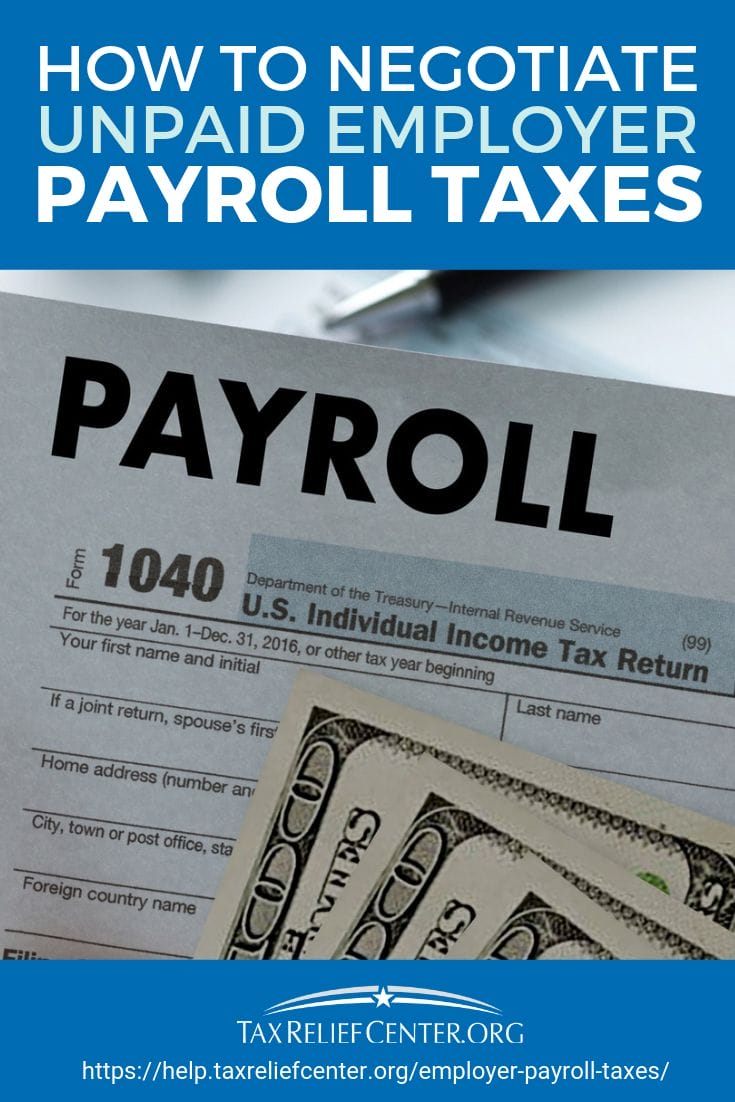Unpaid employer payroll taxes can lead to very steep penalties, but not a lot of taxpayers know how to navigate through the process.
RELATED: Tax Problems? Avoid These Tax Filing Mistakes
Steps on How to Deal With Unpaid Employer Payroll Taxes
Step 1: Know What Falls Under Employer Withholding Tax
Knowing and understanding what is excluded from withholding taxes can really help employers make accurate payments.
There are three main questions to ask:
- Are the workers taxable? Some taxpayers can categorize workers as contractors rather than employees.
If the taxpayer determines where, when, and how the worker performs the role, then he or she is a taxable employee. - Is the compensation taxable? If the amount in question is a salary, then the IRS deems it taxable, together with other classified taxable income, like tips and commissions.
- What kind of payroll taxes apply? The employee pays for federal and state taxes, while employers pay half of the FICA taxes.
FICA Taxes definition: Under The Federal Insurance Contributions Act, employers contribute half of the taxes that pay for Medicare and Social Security.
To make it easier for employers, consider every compensation as taxable, including vacation and severance pays. The IRS Publication 15-B has all the information needed on possible exclusions for fringe benefits.
For employers, the numbers to remember are 6.2% for Social Security tax and 1.45% for Medicare. However, the employer must withhold twice those amounts to cover both their share and the employee’s.
In total, the employer must withhold 15.3%, and pay half from their pockets.
Another interesting point lies with the self-employed. Under the Self-Employed Contributions Act (SECA), self-employed taxpayers shoulder both the employee and employer portions.
The good news for self-employed taxpayers is the employer’s half can fall under a business expense.
Also, if the wages go above $200,000, then there is a .9% Medicare surcharge tax. The employee shoulders this tax but the employer withholds them.
Lastly, even if a taxpayer uses a third party to remit and calculate taxes, the failure of unreceived taxes falls on the taxpayer and not the third party.
Step 2: Understand the Effects of Unpaid Employer Payroll Taxes
There are penalties for sending a late deposit or payment and a penalty for not following guidelines.
For penalties that apply to payments made after the deadline:
- If the payroll taxes are 1 to 5 days late, the employer receives a 2% penalty.
- Taxes 6 to 15 days late merit a 5% penalty.
- For 16 days or more, the employer pays a 10% penalty.
However, the IRS does send a notice and has its own schedule to follow. Deposits made within 10 days from receipt of the first IRS notice receive a 10% penalty.
A 15% penalty applies to unpaid taxes more than 10 days late from the first notice or on the day when the taxpayer receives a notice for immediate payment.
The taxpayer only pays the higher of the two penalties.
Depositing taxes incorrectly will also lead to more penalties.
Of course, any willful or malicious non-compliance of tax laws will lead to criminal and civil charges. The US Tax Code states a fine of up to $10,000, imprisonment of up to 5 years, or both.
Non-payment of taxes has consequences that taxpayers would rather not go through.
RELATED: How To File Back Taxes
Step 3: Get Up to Date on the Employer Portion of Payroll Taxes

The first step is to pay the taxes. The IRS prohibits any negotiations for payroll taxes unless the account is up to date.
Fulfilling tax obligations allows the opening of a case for whether or not a taxpayer should pay the penalties.
To get technical, an employer not paying the payroll taxes becomes a government trustee, which means the IRS can go after the employer without delay by sending the required notices as the issue is no longer just about not fulfilling the law but also not abiding with the contract.
If you have back taxes still unpaid, start with the most current return. The filing is the start of the whole process and can provide taxpayers enough time to prepare.
Filing and paying also lower the penalties and tax debt. In most cases, acquiring a small loan is better than accumulating debt from the IRS as the penalties and interest for not filing and paying taxes are far higher than the rates of a bank loan.
Do note that taxpayers can also apply for an installment plan rather than paying in one lump sum.
Step 4: Prepare the Necessary Forms and Documents
For taxpayers responsible for a sole proprietorship, the IRS requires Form 433-A. This form is pretty straightforward with section 5 for businesses and section 4 for self-employed taxpayers.
On the other hand, taxpayers for an LLC, corporation, and other kinds of businesses which are not sole proprietorships must use Form 433-B.
Both forms collect all necessary information like receivables, revenues, expenses, legal status, and ownership.
For the tax itself, there are two additional forms.
- Form 940 is the Employer’s Annual Federal Unemployment (FUTA) Tax Return.
- Form 941 is for the Quarterly filing.
Taxpayers should not forget to attach other necessary documents like bank statements, bills, pay slips, and other contracts that prove revenue and expenses. These documents can help both the taxpayer and the IRS asses which tax program applies along with other considerations.
For example, if a taxpayer has a good enough reason why the payroll taxes are late, the IRS may cancel the penalties.
A business owner can ask to avail of an Offer in Compromise (OIC) to negotiate a lower tax. Knowing how to properly fill out Form 656 can expedite the process and lessens the risk of rejection.
A comprehensive guide regarding forms may help you find and fill out forms.
Step 5: Try to Lower Payroll Taxes by Adding Exempt Benefits
This step works more as a preventive measure rather than a solution.
Instead of giving a raise, an employee can actually gain more financially if the employer gives more fringe benefits. The employer may need to pay less taxes as the FICA rates do not apply to fringe benefits.
For example, an employer can give care assistance of up to $5,000 for dependents who need qualified care. Group-term life insurance is also another exemption.
Providing meals and even lodging for employees within the business premises as a benefit can help both employer and employee as there are no FICA taxes applicable to such.
Another possible deduction can come in the form of paying corporate directors which the IRS can acknowledge.
This method, however, has a lot of complexities, with legal requirements as well as paperwork necessary. If the taxpayer is a corporation, it is best to talk to a tax advocate to know more about other possible tax deductions.
These 5 steps are crucial for taxpayers with unpaid employer payroll taxes, but each case is different from the others. Talking to a lawyer, accountant, or tax specialist may prove helpful as payroll taxes affect not just the taxpayer but also the employee.
Do you have questions about employer payroll taxes? How about other tax concerns? Let us discuss in the comments section below.
If you owe back taxes, visit taxreliefcenter.org for more information on tax relief options.
Up Next:
- Tax Relief For Deserving Americans
- 12 Reasons To Speak To A Tax Relief Specialist About Your Back Taxes ASAP
- Tax Penalty For Underpayment [2019 Edition]


